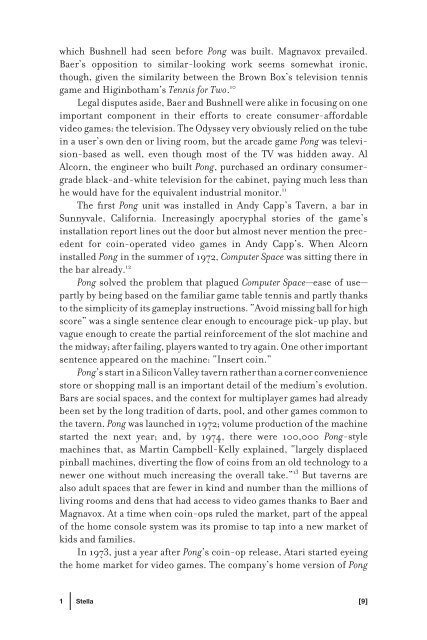Racing the Beam : the Atari Video Computer System - Index of
Racing the Beam : the Atari Video Computer System - Index of
Racing the Beam : the Atari Video Computer System - Index of
Create successful ePaper yourself
Turn your PDF publications into a flip-book with our unique Google optimized e-Paper software.
which Bushnell had seen before Pong was built. Magnavox prevailed.<br />
Baer’s opposition to similar-looking work seems somewhat ironic,<br />
though, given <strong>the</strong> similarity between <strong>the</strong> Brown Box’s television tennis<br />
game and Higinbotham’s Tennis for Two. 10<br />
Legal disputes aside, Baer and Bushnell were alike in focusing on one<br />
important component in <strong>the</strong>ir efforts to create consumer-affordable<br />
video games: <strong>the</strong> television. The Odyssey very obviously relied on <strong>the</strong> tube<br />
in a user’s own den or living room, but <strong>the</strong> arcade game Pong was television-based<br />
as well, even though most <strong>of</strong> <strong>the</strong> TV was hidden away. Al<br />
Alcorn, <strong>the</strong> engineer who built Pong, purchased an ordinary consumergrade<br />
black-and-white television for <strong>the</strong> cabinet, paying much less than<br />
he would have for <strong>the</strong> equivalent industrial monitor. 11<br />
The fi rst Pong unit was installed in Andy Capp’s Tavern, a bar in<br />
Sunnyvale, California. Increasingly apocryphal stories <strong>of</strong> <strong>the</strong> game’s<br />
installation report lines out <strong>the</strong> door but almost never mention <strong>the</strong> precedent<br />
for coin-operated video games in Andy Capp’s. When Alcorn<br />
installed Pong in <strong>the</strong> summer <strong>of</strong> 1972, <strong>Computer</strong> Space was sitting <strong>the</strong>re in<br />
<strong>the</strong> bar already. 12<br />
Pong solved <strong>the</strong> problem that plagued <strong>Computer</strong> Space—ease <strong>of</strong> use—<br />
partly by being based on <strong>the</strong> familiar game table tennis and partly thanks<br />
to <strong>the</strong> simplicity <strong>of</strong> its gameplay instructions. “Avoid missing ball for high<br />
score” was a single sentence clear enough to encourage pick-up play, but<br />
vague enough to create <strong>the</strong> partial reinforcement <strong>of</strong> <strong>the</strong> slot machine and<br />
<strong>the</strong> midway; after failing, players wanted to try again. One o<strong>the</strong>r important<br />
sentence appeared on <strong>the</strong> machine: “Insert coin.”<br />
Pong’s start in a Silicon Valley tavern ra<strong>the</strong>r than a corner convenience<br />
store or shopping mall is an important detail <strong>of</strong> <strong>the</strong> medium’s evolution.<br />
Bars are social spaces, and <strong>the</strong> context for multiplayer games had already<br />
been set by <strong>the</strong> long tradition <strong>of</strong> darts, pool, and o<strong>the</strong>r games common to<br />
<strong>the</strong> tavern. Pong was launched in 1972; volume production <strong>of</strong> <strong>the</strong> machine<br />
started <strong>the</strong> next year; and, by 1974, <strong>the</strong>re were 100,000 Pong-style<br />
machines that, as Martin Campbell-Kelly explained, “largely displaced<br />
pinball machines, diverting <strong>the</strong> fl ow <strong>of</strong> coins from an old technology to a<br />
newer one without much increasing <strong>the</strong> overall take.” 13 But taverns are<br />
also adult spaces that are fewer in kind and number than <strong>the</strong> millions <strong>of</strong><br />
living rooms and dens that had access to video games thanks to Baer and<br />
Magnavox. At a time when coin-ops ruled <strong>the</strong> market, part <strong>of</strong> <strong>the</strong> appeal<br />
<strong>of</strong> <strong>the</strong> home console system was its promise to tap into a new market <strong>of</strong><br />
kids and families.<br />
In 1973, just a year after Pong’s coin-op release, <strong>Atari</strong> started eyeing<br />
<strong>the</strong> home market for video games. The company’s home version <strong>of</strong> Pong<br />
1 Stella [9]


